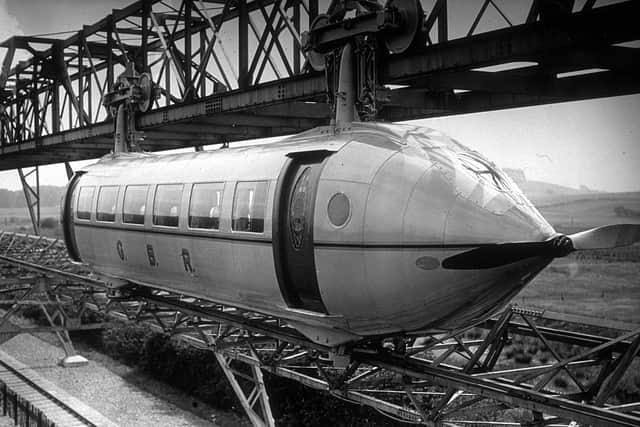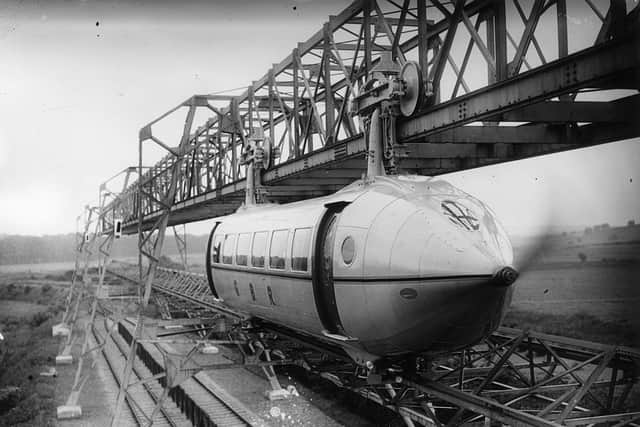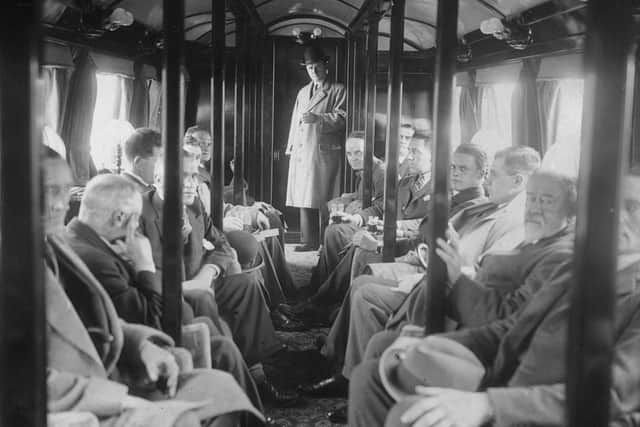The tragic story behind the inventor of Glasgow’s 1930 retro sci-fi ‘rail-plane’
and live on Freeview channel 276
The Railplane was an incredible invention - it was so ahead of its time, even looking at it now it looks like a far-off futuristic mode of transport - but why did it never come to fruition?
Inventor, George Bennie, was born in Auldhouse - a small village near East Kilbride in 1891 - growing up in an incredibly transitory time for the people of Scotland. Glasgow was a great industrial force, the plumes of black smoke rising from countless sky-high chimneys drawing workers in like a beacon.
Advertisement
Hide AdAdvertisement
Hide AdWhile he was born just outside of Glasgow - Bennie spent most of his early years growing up on Rothesay on the Isle of Bute, far enough from Glasgow to have clean air and blue seas, but not far enough to resist it’s draw. If there was anywhere George Bennie was going to make a name for himself, it was going to be in Glasgow.
Bennie had filed numerous patents in his young life, but it wasn’t until his late 20’s that he believed he had something life-changing, not just for himself, but for the entire world.
Inspired by his father, who was also a hydraulic engineer, Bennie drew up the first schematics for the railplane at 30 years old in 1921, they were patented two years later in 1923. He believed the railplane would be able to make the journey from Glasgow to Edinburgh in 20 minutes flat, reaching speeds of up to 150mph (although this was later lowered in estimations to around 120mph), something that’s not possible even today (at top speeds Scotrail trains reach around 125mph).
In function, it was propelled and brought to a halt using propellors on either end of the carriage - in form it looked like a cross between a train, a monorail, and a submarine.
Advertisement
Hide AdAdvertisement
Hide AdThe Railplane was designed to be fitted on tracks around 15-20 feet over existing train lines, essentially making passenger transport travel along a single rail, while Bennie proposed that heavy freight like coal and steel remain on the ground tracks. A very captivating proposal for an industrial nation with railway lines congested with hundreds of thousands of people, and hundreds of thousands of tonnes of coal, iron, and steel.


Bennie was entirely devoted to his railplane schematic, it was his life work, and he was going to make it happen. After struggling to capture the interets of investors, Bennie funded most of the initial construction of the railplane, set to be displayed on 400 feet of specialist overhead track he would also need to build himself.
He was so sure of himself and his schematic, that Bennie described the Railplane as such:” The Railplane is as great a step in the evolution of rail transport as the motor car was to the stagecoach in road transport.”
The construction of the railplane seemed like a pipe-dream, but through sheer force of will (and much of his existing fortune) he saw through the construction at the Dalmuir works of William Beardmore & Co Ltd of Inchinnan in Renfrewshire - who had experience designing airships.
Advertisement
Hide AdAdvertisement
Hide AdIn 1930, the railplane was finally ready to show off - Bennie was positive that once investors saw the railplane in practice, they would have no choice but to invest.
Over in Milngavie, black and white footage captures Bennie shaking the hands of big-wigs of the railway industry as they enter the single Railplane carriage through a sliding door from the elevated platform.


The film reel opens with a promise relayed from George Bennie not only to investors, but to the world at large, it read:”The George Bennie Railplane.
“Novel method of high speed transport...
“Claimed to be cheaper, faster, and safer...
“successfully tried out.”
The interior was plushed up to an incredible degree, taking inspiration from the Art-Deco architecture of the era, the carriage was opulent to say the least, with armchairs, stained glass windows, carpeted floors, and table lamps - Bennie was clearly trying to impress.
Advertisement
Hide AdAdvertisement
Hide AdNo technical issues were encountered during the quarter-mile test flight in 1930, in fact it went incredibly well, with one passenger telling the press of the time:“The Railplane operated with perfect smoothness and passengers only knew the car was moving by gazing out of the window at the passing landscape.
“There was no bumping over rails, smoke or whistle shrieking. A ride in the coach is sheer delight.”
So why don’t we see any Railplane’s whizzing above the city streets of Glasgow in 2023, nearly 100 years later?
The exhibition drew considerable interest, such was the captivating nature of Railplane - there were even proposals for lines between Blackpool and Southport, even investors from the south of France seemed interested, but tragically - nothing ever came to fruition.
Advertisement
Hide AdAdvertisement
Hide AdIn 1930, it was the beginning of the great depression - and investors were being pretty cagey with their money, particaular in unproved techonology that just seemed too futuristic to be feasible.


It’s true we don’t know how feasible the Railplane could have been, as undeniably cool a concept it was, saying you can travel from Glasgow to Edinburgh in 20 minutes is enough to get anyone to think you’re mental.
As impressive as the exhibition was, 400 feet of test track was not enough to convince investors that this brave new technology would be viable, or if was even possible.
After six years of desperately trying to convince investors - Bennie was ousted for the board of his own company in 1936, and would have no further involvement in the business. A year later, in 1937, he declared bankruptcy.
Advertisement
Hide AdAdvertisement
Hide AdUndeterred by financial ruin, he recovered and formed two new companies: Bennie Airspeed Railway Ltd in 1946, and George Bennie Airspeed Railway (Iraq) Ltd in 1951.
Blown off and disgraced by the British railway industry, George had turned his sight to the Middle East - providing passenger services to desert cities and destinations around the River Nile, the Dead Sea, Baghdad, and Damascus.
However, he faced similar problems on the other side of the world as he did at home. He just couldn’t get anyone interested in the futuristic technology. All the while, the original exhibition Railplane track lay rusting above the disused railway line in Milngavie.


Despite surviving World War 2 and the severe need for scrap metal for the war effort - the railplane and the quarter mile of steel it was suspended from were still where Bennie had left them in a field in Milngavie.
Advertisement
Hide AdAdvertisement
Hide AdBennie returned home after failing in the Middle East as he had at home, now in his 60’s, he no longer had the will to continue his life-long dream - reportedly setting up a herbalist shop, swapping steel and schematics for herbs and tonics, far from his beginnings as an enterprising industrialist.
It wasn’t until 1956 that the Railplane was dismantled and sold for scrap - Bennie died in obscurity the following year.
Over his lifetime, Bennie had reportedly invested £150,000 of his own money - the equivalent of £9.8m. He was so certain of his success - spending over half of his life pushing for an invention that never came to fruition.
An invention from an overlooked industrialist that could have changed the world as we know it? Or a pipe-dream that would never have worked by a wacky yet arrogant inventor? We’ll never truly know.
Comment Guidelines
National World encourages reader discussion on our stories. User feedback, insights and back-and-forth exchanges add a rich layer of context to reporting. Please review our Community Guidelines before commenting.
